It’s not East Africa nor the Memphis Zoo, but I’m sitting in a room made mostly of bamboo and reed matting for walls, a jungle of trees (blackberry, Banyan, Kapok, Sal) listening to jungle sounds – monkeys screeching, crazy crickets breeetting, minor birds, Indian cucko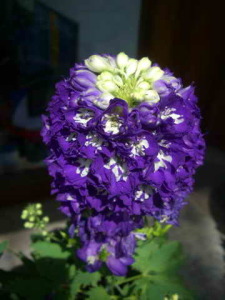 o, Jungle Babbler, Oriental Turtle Dove singing, and elephants trumpeting. I try to imagine sounds of a tiger or leopard or a sloth bear.
o, Jungle Babbler, Oriental Turtle Dove singing, and elephants trumpeting. I try to imagine sounds of a tiger or leopard or a sloth bear.
We just arrived in a familiar open air landrover and immediately it was deja vu – remembering the landrovers that were our life source in Karatu, Ta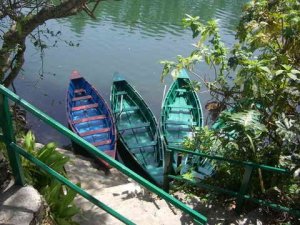 nganyika when I lived there in 1962-3. We crossed a river in a wooden canoe for passengers, looking out for Marsh Mugger crocodiles and Gharial peeping through eye holes just above water. But don’t get in a rush. We are just arriving after a tediously long drive from Pokhara. We have time for safaris into the tall grasses and jungles.
nganyika when I lived there in 1962-3. We crossed a river in a wooden canoe for passengers, looking out for Marsh Mugger crocodiles and Gharial peeping through eye holes just above water. But don’t get in a rush. We are just arriving after a tediously long drive from Pokhara. We have time for safaris into the tall grasses and jungles.
Our original car and driver had a wreck before he got to us in Pokhara, so we hired a van that was air conditioned and went to the street wars again. Talk about from one extreme to the other! Back to traffic, huge trucks and buses with fronts decorated like angry masks, motorcycles by the thousands, people strolling anywhere paying no attention to your beep, and worse, roads that had not been repaired once in their lifetime. It took us six hours to go 150 kilometers with no break for lunch. We had stopped in Pokhara and loaded up on hard candies and peanuts at what some call a supermarket.
The road through tightly packed mountains was constant chaos of fat trucks and buses, motorcycles and pedestrians as well as continual town and villages. We bumped our way through Narayanghat and Bharatpur, then came the worst part to Megauli and an airport where we were greeted by military and a rep from Tiger Tops with a waiting landrover. It took hours just to reach the open country outside Pokhara. The three story houses continue to be flat roofed, brightly painted, surrounded in balconys and patterned in stones and bric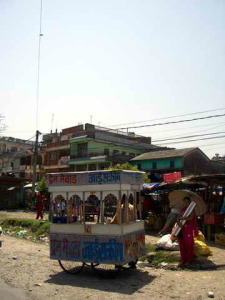 ks so
ks so each was an art work. In many cases on the roof you saw Buddhist temples and altars, the daily laundry, vertical prayer flags and big black water tanks to catch the rain. Some Buddhist built colorful altars with the eyes of Buddha on all sides right in the front yard.
each was an art work. In many cases on the roof you saw Buddhist temples and altars, the daily laundry, vertical prayer flags and big black water tanks to catch the rain. Some Buddhist built colorful altars with the eyes of Buddha on all sides right in the front yard.
Once we reached a rendition of country, the tiered plots were filled with rice seedlings. Women bent over in Vs planting and weeding. Because we were gradually reaching low altitude, the heat was stifling and to add to the beautiful female fashion there were colorful umbrellas for shade. I saw on young man sitting at a distance in the shade watching a half dozen cattle and holding an umbrella over his head. It made me giggle. We were roasting even in the “air-conditioned” van. I believe air-conditioning is rel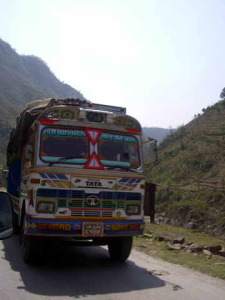 ative here. And I’m not kin.
ative here. And I’m not kin.
Chitwan National Park is a jungle reserve in southern Nepal guarded by the military, vigilant for poachers and trying to stay out of the political insecurities of this month. We are staying at Tiger Tops and it appears out of the jungle with the subtle swagger of a Bengal tiger. It is a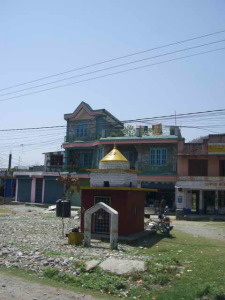 pioneer of environmentally responsible nature tourism in Nepal and their lodges are copied throughout the world. It is administered by the Government of Nepal but is a private organization.
pioneer of environmentally responsible nature tourism in Nepal and their lodges are copied throughout the world. It is administered by the Government of Nepal but is a private organization.
After a 45 minute landrover ride through deep waters and into “real” jungle, we were welcomed by a young Swiss girl here on a tour of duty and she offered us ICED mint tea (literally a cube of ice made from boiled water) and a slice of banana cake. It’s the first ice since I left home but is safe because all their water is boiled and filtered. Tiger Tops is not air conditioned other than by a fan in your room but the music all around from the birds, insects, elephants living next door and people going about their greeting labors are comforting. There is a good bathroom, electricity for lights but no plugs for charging, and a promise of a good night sleep. I’m content to just be somewhere for more than one night. We are scheduled here for four nights.
What challenges me is dealing with the dark. I’m used to living in a city where no matter what window I’m at, everything outside is lit up. In Memphis we have no darkness. We have street lights, porch lights, automatic lights that come on and go off according to dawn and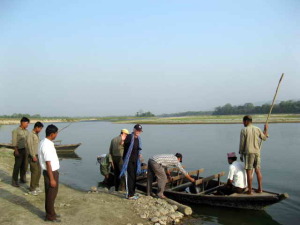 dusk. Indoors, we live with televisions, computers, DVD players, printers, digital clocks and alarm systems that all seem to have light continually on. One can walk around the house just from those lights. But here, when it’s night, it’s night. For someone blind as I am in the night, it’s a bit hairy. My room, though, has two flashlights and there is a sort of electricity, solar powered, that comes in two gas lamps in which are the new “green” light bulbs, which I have at home but am never able to read by. But the fan worked all night. That’s important in such heavy heat as there is in a jungle situation.
dusk. Indoors, we live with televisions, computers, DVD players, printers, digital clocks and alarm systems that all seem to have light continually on. One can walk around the house just from those lights. But here, when it’s night, it’s night. For someone blind as I am in the night, it’s a bit hairy. My room, though, has two flashlights and there is a sort of electricity, solar powered, that comes in two gas lamps in which are the new “green” light bulbs, which I have at home but am never able to read by. But the fan worked all night. That’s important in such heavy heat as there is in a jungle situation.
As I climbed to my room and strolled around the deck, I saw in the distance (without my glasses) a gray blob. On focusing, I discovered it was a langur monkey with its black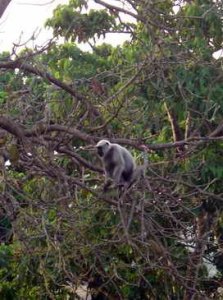 face and long gray hair. Wow, I thought. I don’t even like monkeys but at once was awed by this species in the wild. We had also seen a spotted deer buck and two females on the dirt road inside the park and there are rumors of a male elephant out of control and not yet done with his mating season. He ran past the viewing area of Tiger Tops about cocktail hour. As I write this
face and long gray hair. Wow, I thought. I don’t even like monkeys but at once was awed by this species in the wild. We had also seen a spotted deer buck and two females on the dirt road inside the park and there are rumors of a male elephant out of control and not yet done with his mating season. He ran past the viewing area of Tiger Tops about cocktail hour. As I write this , I hear the elephants stirred into trumpeting like crazy and jackles screaming. The whole place is one big jumble of sound sure better than any thing on anyone’s Ipod. Now, once again after 45 years, I’m in my kind of paradise.
, I hear the elephants stirred into trumpeting like crazy and jackles screaming. The whole place is one big jumble of sound sure better than any thing on anyone’s Ipod. Now, once again after 45 years, I’m in my kind of paradise.
Photos: A hydrangea in Fish Tail Lodges enchanting garden. 2) Canoes to go. 3) Leaving the hotel. 4) Ice cream vendor in a village. 5) Buddhist temple. 6) Monster buses. 7) Crossing the river in Chitwan. 8) Langur monkey. 9) Tiger Tops rooms.
 o, Jungle Babbler, Oriental Turtle Dove singing, and elephants trumpeting. I try to imagine sounds of a tiger or leopard or a sloth bear.
o, Jungle Babbler, Oriental Turtle Dove singing, and elephants trumpeting. I try to imagine sounds of a tiger or leopard or a sloth bear.We just arrived in a familiar open air landrover and immediately it was deja vu – remembering the landrovers that were our life source in Karatu, Ta
 nganyika when I lived there in 1962-3. We crossed a river in a wooden canoe for passengers, looking out for Marsh Mugger crocodiles and Gharial peeping through eye holes just above water. But don’t get in a rush. We are just arriving after a tediously long drive from Pokhara. We have time for safaris into the tall grasses and jungles.
nganyika when I lived there in 1962-3. We crossed a river in a wooden canoe for passengers, looking out for Marsh Mugger crocodiles and Gharial peeping through eye holes just above water. But don’t get in a rush. We are just arriving after a tediously long drive from Pokhara. We have time for safaris into the tall grasses and jungles.Our original car and driver had a wreck before he got to us in Pokhara, so we hired a van that was air conditioned and went to the street wars again. Talk about from one extreme to the other! Back to traffic, huge trucks and buses with fronts decorated like angry masks, motorcycles by the thousands, people strolling anywhere paying no attention to your beep, and worse, roads that had not been repaired once in their lifetime. It took us six hours to go 150 kilometers with no break for lunch. We had stopped in Pokhara and loaded up on hard candies and peanuts at what some call a supermarket.
The road through tightly packed mountains was constant chaos of fat trucks and buses, motorcycles and pedestrians as well as continual town and villages. We bumped our way through Narayanghat and Bharatpur, then came the worst part to Megauli and an airport where we were greeted by military and a rep from Tiger Tops with a waiting landrover. It took hours just to reach the open country outside Pokhara. The three story houses continue to be flat roofed, brightly painted, surrounded in balconys and patterned in stones and bric
 ks so
ks so each was an art work. In many cases on the roof you saw Buddhist temples and altars, the daily laundry, vertical prayer flags and big black water tanks to catch the rain. Some Buddhist built colorful altars with the eyes of Buddha on all sides right in the front yard.
each was an art work. In many cases on the roof you saw Buddhist temples and altars, the daily laundry, vertical prayer flags and big black water tanks to catch the rain. Some Buddhist built colorful altars with the eyes of Buddha on all sides right in the front yard.Once we reached a rendition of country, the tiered plots were filled with rice seedlings. Women bent over in Vs planting and weeding. Because we were gradually reaching low altitude, the heat was stifling and to add to the beautiful female fashion there were colorful umbrellas for shade. I saw on young man sitting at a distance in the shade watching a half dozen cattle and holding an umbrella over his head. It made me giggle. We were roasting even in the “air-conditioned” van. I believe air-conditioning is rel
 ative here. And I’m not kin.
ative here. And I’m not kin.Chitwan National Park is a jungle reserve in southern Nepal guarded by the military, vigilant for poachers and trying to stay out of the political insecurities of this month. We are staying at Tiger Tops and it appears out of the jungle with the subtle swagger of a Bengal tiger. It is a
 pioneer of environmentally responsible nature tourism in Nepal and their lodges are copied throughout the world. It is administered by the Government of Nepal but is a private organization.
pioneer of environmentally responsible nature tourism in Nepal and their lodges are copied throughout the world. It is administered by the Government of Nepal but is a private organization.After a 45 minute landrover ride through deep waters and into “real” jungle, we were welcomed by a young Swiss girl here on a tour of duty and she offered us ICED mint tea (literally a cube of ice made from boiled water) and a slice of banana cake. It’s the first ice since I left home but is safe because all their water is boiled and filtered. Tiger Tops is not air conditioned other than by a fan in your room but the music all around from the birds, insects, elephants living next door and people going about their greeting labors are comforting. There is a good bathroom, electricity for lights but no plugs for charging, and a promise of a good night sleep. I’m content to just be somewhere for more than one night. We are scheduled here for four nights.
What challenges me is dealing with the dark. I’m used to living in a city where no matter what window I’m at, everything outside is lit up. In Memphis we have no darkness. We have street lights, porch lights, automatic lights that come on and go off according to dawn and
 dusk. Indoors, we live with televisions, computers, DVD players, printers, digital clocks and alarm systems that all seem to have light continually on. One can walk around the house just from those lights. But here, when it’s night, it’s night. For someone blind as I am in the night, it’s a bit hairy. My room, though, has two flashlights and there is a sort of electricity, solar powered, that comes in two gas lamps in which are the new “green” light bulbs, which I have at home but am never able to read by. But the fan worked all night. That’s important in such heavy heat as there is in a jungle situation.
dusk. Indoors, we live with televisions, computers, DVD players, printers, digital clocks and alarm systems that all seem to have light continually on. One can walk around the house just from those lights. But here, when it’s night, it’s night. For someone blind as I am in the night, it’s a bit hairy. My room, though, has two flashlights and there is a sort of electricity, solar powered, that comes in two gas lamps in which are the new “green” light bulbs, which I have at home but am never able to read by. But the fan worked all night. That’s important in such heavy heat as there is in a jungle situation.As I climbed to my room and strolled around the deck, I saw in the distance (without my glasses) a gray blob. On focusing, I discovered it was a langur monkey with its black
 face and long gray hair. Wow, I thought. I don’t even like monkeys but at once was awed by this species in the wild. We had also seen a spotted deer buck and two females on the dirt road inside the park and there are rumors of a male elephant out of control and not yet done with his mating season. He ran past the viewing area of Tiger Tops about cocktail hour. As I write this
face and long gray hair. Wow, I thought. I don’t even like monkeys but at once was awed by this species in the wild. We had also seen a spotted deer buck and two females on the dirt road inside the park and there are rumors of a male elephant out of control and not yet done with his mating season. He ran past the viewing area of Tiger Tops about cocktail hour. As I write this , I hear the elephants stirred into trumpeting like crazy and jackles screaming. The whole place is one big jumble of sound sure better than any thing on anyone’s Ipod. Now, once again after 45 years, I’m in my kind of paradise.
, I hear the elephants stirred into trumpeting like crazy and jackles screaming. The whole place is one big jumble of sound sure better than any thing on anyone’s Ipod. Now, once again after 45 years, I’m in my kind of paradise.Photos: A hydrangea in Fish Tail Lodges enchanting garden. 2) Canoes to go. 3) Leaving the hotel. 4) Ice cream vendor in a village. 5) Buddhist temple. 6) Monster buses. 7) Crossing the river in Chitwan. 8) Langur monkey. 9) Tiger Tops rooms.
